
Pain de Campagne with Gilchesters Farmhouse Flour
Pain de Campagne using a Stiff Wheat Levain and a portion of Gilchesters Organic Farmhouse Flour
Leaven Build
Material | Recipe [grams] |
1. Leaven Build One | Saturday, 15:00 Refrigerate Overnight |
Leaven | 60 |
White Bread Flour [Marriage’s Organic Strong White Flour] | 100 |
Water | 60 |
TOTAL | 220 |
|
|
2. Leaven Build Two | Sunday, 11:00 |
Leaven from above | 220 |
White Bread Flour | 100 |
Water | 60 |
TOTAL | 380 |
|
|
3. Leaven Build Three | Sunday, 19:00 Refrigerate Overnight |
Leaven from above | 380 |
White Bread Flour | 200 |
Water | 120 |
TOTAL | 700 |
Final Dough Formula
Material | Formula [% of flour] | Recipe [grams] |
Leaven from above | Flour: 22.22 + Water: 13.33 Total: 35.55 | 400 + 240 640 |
Carrs Special CC Flour | 50 | 900 |
Gilchesters Organic Farmhouse Flour | 27.78 | 500 |
Salt | 1.78 | 32 |
Water | 55.56 | 1000 |
TOTAL | 170.76 | 3072 |
Overall Pre-fermented Flour | 22.22 | - |
Overall Hydration | 68.89 | - |
Flour Mix | 72.22% White Bread Flour 27.78% High Extraction Flour | - |
Method:
- Combine both flours with the water and autolyse refrigerated overnight
- Combine the autolyse with the leaven and work up the dough for 3 minutes. Add the salt and develop a further 3 minutes. Rest for 15 minutes. Develop a further 5 minutes.
- Bulk proof for 3 hours. One S&F after 2hours.
- Scale and divide into 3 pieces: 1 x 650g, 1 x 930g and the remainder, 1492g
- Final proof in Bannetons for 4 hours
- Bake Profile for the largest loaf, I loaded the loaf, once tipped out and cut, into an oven at 250°C and utilised steam. After 15 minutes I turned the heat down to 220°C. After another 20 minutes I turned the heat down to 200°C and baked the loaf out a further 20 minutes. Then I left the loaf in the oven, switched off, with the door propped open. Finally I cooled the loaf on wires before the inevitable photo shoot.
One note: a long proof, accounted for by use of refrigerated autolyse and leaven. The dough proof temperature ranged between 18 and 23°C. Seven hours of total proving was just about right; the percentage of pre-fermented flour is reduced on most of the breads of this nature which I have been baking recently Photographs are shown below; tastings have not yet been carried out.
Very best wishes
Andy
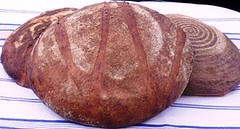
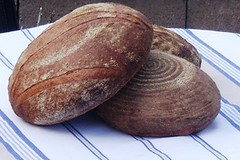
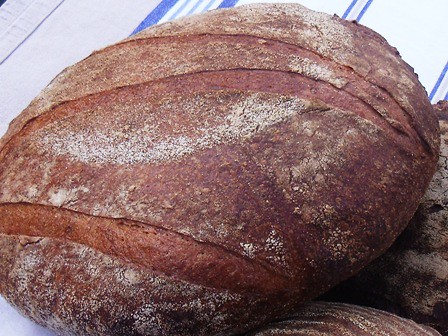

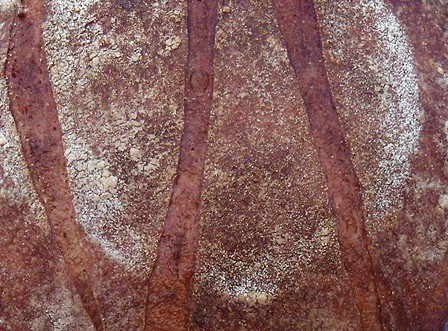
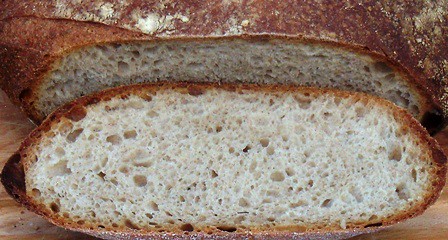
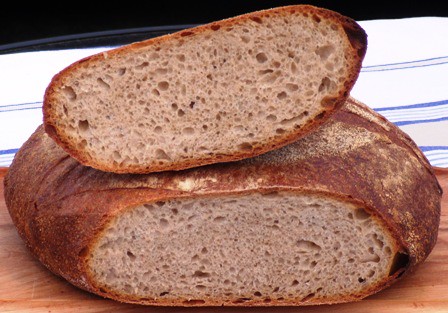




Comments
Just all round lovely looking, crust and crumb. But I'm inspired by the overnight autolyse and subsequent addition of levain and etc. That's new to me! Tell me about the flavor: I know that the long autolyse is going to go a long ways toward gluten development, but what is the impact on flavor development sans the levain/yeast?
Larry
Hi Larry,
Good to find you back at TFL, have you been granted just a little time off?
Your post sent me off to the kitchen for an analytical taste of the bread. We hadn't tried it up to this point.
I'm loving the delicate flavours from a reduced levain, slowly developed and fermented cold. The chief impact of the autolyse really comes through in the crumb, which is wonderfully "chewy", as all the best bread is when good levels of water absorption are achieved. I consider 69% to be good in wheat bread.
The main impact in the process was exactly as you anticipated. Gluten development was rapid and substantial. High quality dough thus, the result.
Always good when you stop by to comment
Best wishes
Andy
taking your skills for granted if I say beautiful loaves as usual. But really, beautiful loaves! I have been wondering how best to follow your Gilchester formulas with flour that is more readily available in North America. Do you have any suggestions? -Varda
http://www.growseed.org/now.html
http://www.hungryghostbread.com/pages/the_little_red_hen_restoring_wheat_in_the_pioneer_valley.php
Hi Varda,
Here's a couple of articles you may care to look at? Local wheat in MA!
It's interesting to find you asking questions about this. The mainstream on TFL often discuss AP flour as being more suited to Artisan bread. Clearly "AP" in North America equates better with our bread flour than "plain".
By all means celebrate that the North American/Canadian [&, yes, I confine my comments to "North" here] enjoys an idyllic climate for growing strong wheat. But, do investigate how strains have been so tampered with. Modern wheat bears little resemblence to the sort of grain I am using, and pointing you to in the links above.
I really hope you give it a try, in any type of bread. And I'll take your comments as a compliment actually, as I believe that was your intention with what you wrote.
All good wishes and thanks
Andy
Andy,
Very interesting articles on wheat....Thanks for posting the links!
I have a question is about your leaven builds. I thought that when building up a leaven you always want to a least meet it's weight or double the leaven you begin with. (2:1:1 or 1:2:2)
I noticed you did that in build #1 but in the 2 subsequent builds you did not.
How do you get away with feeding a yeast population less food that it's current weight without killing some of it off and hence, jeopardizing your leaven's leavening ability in the final dough?
Janet
Hi Janet,
feeding a levain is quite complex, so I have always avoided using the ratios to which you make reference. I know it works for quite a few people on TFL, and that's great.
But, I think you are missing one crucial component here. I also believe that you feed your levain at regular intervals and keep it ambient. I use the fridge! I keep a small portion of the refreshed and ripened leaven back, and that goes in to the fridge to form the basis of my next leaven for whenever I bake in the future. That might be a month away!!!
If the time lapse is a long time, then the leaven will need greater care in the feeding regime to make it ready to use in a dough. But also note, that I used the fridge extensively in cultivating the leaven this time round through feeding. This was to slow down both wild yeast and bacterial growth.
Honestly: I knew I wanted 640g of leaven for the dough i was making, and needed 50 -80 leftover for next time. So my feeding regime was just designed to produce c.700g of leaven which was ready at the right time for me to make the final dough. I started the build on the Saturday afternoon, and it was ready on the Monday morning. this works so much better for me than keeping it on the bench and feeding at regular intervals. I just know that I would forget the feed on a regular basis. And, I don't bake often enough at home to justify this sort of procedure to myself. However, my first build will usually involve a generous feed as I'm aware my stock leaven will likely have been in the fridge a wee while and needs plenty of help to get it moving again.
But, I don't "get away" with anything...nobody ever does, on a regular basis, with real bread. It's a matter of how ripe the leaven has become at the point when it is fed. A period in the fridge will retard the development of all aspects of the culture to a considerable degree. So, I factor that in to the feeding schedule as a tool I can use to my benefit.
It was good to find easy references to local flour for where varda lives. You are obviously based many miles away from here. I don't know anything about wheat in Colorado; you'd have to tell me about that.
All good wishes
Andy
Andy,
Silly me expecting an easy answer..... ;^)
One would think that I would have learned that there are NO easy answers here!!!
But I am a slow learner and your answer has spawned several more questions for which I am sure there will be no easy answers....
I am a total novice at this whole bread baking thing so a lot of what I do is observe and try to make sense of what it is I am observing so that I can ultimately have a bit more control when baking....ROFL....mostly I am out of control =:-0 but figure if I keep at this for the rest of my life I might have learned a thing or two....
I do understand the use of a refrigerator to slow things down. I used to keep my starter in the fridge when I first began using SD but then decided to keep it out on my counter to see which method I preferred. The amount I keep out is minimal (5:9:15) because my baking times are not set - some days I use it, some days not...I always do a build or 2 prior to adding it to a final dough just to see check out it's strength.
I have never read of doing it your way as a means of slowing things down. I generally overfeed my starter to slow it down - too much food with less water and cooler temps is how I have managed my builds but now you have introduced a new method so naturally my curiosity has been stirred...
So now to my questions: Is it not true then that the yeast will suffer from less food? I am puzzled because it seems like you are feeding it less than what it would need to reproduce - the population would be bigger than it's 'rations' and a portion of the population would then be compromised due to lack of food.....
I guess to state it another way - just how does one know how much food to feed a specific amount of starter? If you are underfeeding it, how then does it have the 'strength' to rise a dough 'properly'.
I will stop with just these 2 questions but I fear when I read your response there will inevitably be more to follow! :-)
As for my grains....I am not sure from where all of the grains I use originate. Currently I have some hard white winter wheat that is grown in Nebraska and some rye that is grown in Canada. (I only know that because both bags are still intact. The rest of my grains are in storage containers and their wrappings are long gone.) The woman I purchase from tries to find family farms to support and her grains are always organic. I usually keep kamut, spelt, rye, red spring wheat, red winter wheat, soft white wheat, barley, oat grouts and a mixture of 7 grains on hand so the sources are many....I will attempt to pay closer attention in the future ;^).
Thanks for sharing you knowledge!
Janet
Hi Janet,
So, I would like to know how you can attibute a certain number of known wild yeasts living within your portion of sourdough? It just doesn't work like that, although I do take your point that insufficient fresh flour in any feeding period will mean that the yeasts die off. But I don't think the level of flour I used was mean enough to cause them to die, far from it. Use of cooler temperatures means everything will be slowed down, so the food made available to the wild yeasts will be used up more slowly.
To illustrate my point, and why I don't use the ratios:
In my formula, I started with 60g of leaven from the fridge, that would be made up of 37.5g flour [and 22.5g water]. The refreshment pattern ened up with 437.5g of flour. So the original pre-fermented flour in the stock makes up 8.57% of the flour in the final leaven. That's a pretty healthy dose of fresh flour to be using [over 91% of the total flour in the leaven].
Then in the final dough, you see I have quoted pre-fermented flour at 22.22% of the total flour mix. We can't be totally accurate here, as there has to be some consideration given to the small portion of leaven held back as stock. However, if we ignore that and look at the very biggest picture, then I used 37.5g of pre-fermented flour to create a leaven, then to make a final dough where total flour content was 1800g. This means that the % of flour in the stock leaven on the overall flour content in the dough was just a fraction over 2%.
I've put these details down to try and encourage you to think in a slightly different way about this. Rather than being overly concerned with ratios, I much prefer to look in depth at the amount of pre-fermented flour in the formula. I just take the valuable knowledge Khalid was handing down as a given. The more liquid in the equation, the quicker the culture will ferment, so long as there is enough food available [and I think you have grasped this very well]. Indeed I build this into my teaching in College at all levels of breadmaking from Level 2 up, and for all styles of dough too.
Most critical of all is ensuring the leaven is balanced and has sufficient lactic and acetic bacteria available as well as wild yeasts. Khalid made exactly this point in his recent post which you were involved with. Bacteria outnumber wild yeasts significantly in terms of population numbers. My thought is that your method is really only concentrating on looking after the wild yeasts. But you need the bacterial element for all sorts of reasons: flavour, rheology and fermentation related.
Anyway you actually asked 3 questions. The short answers are: 1] No, not necessarily, if the feeding regime is controlled, but yes, most certainly if the food supply is genuinely insufficient. 2] Think pre-fermented flour here; but, there is no hard and fast rule that says 5g of leaven contains 15million yeast cells and they require 2.2g of flour each every 6 hours [illustration only]. 3] underfeeding significantly will indeed weaken the leavening power from yeasts. BUT, there are 2 biggies to grasp here; firstly there was no underfeeding going on in this instance, and secondly, successful sourdough leavening is based on the symbiotic relationship between cultivated wild yeast population and acetic and lactic bateria. All are essential, and purely concentrating on feeding up wild yeasts will not alone lead to good bread.
I do hope I'm helping to clarify the picture for you and not muddy the waters further.
All good wishes
Andy
Thanks Andy,
I have noticed certain people here list the amount of flour in the pre-ferment and have been puzzled by that but now, with your explanation, things are making a bit more sense but this is still way over my head =:-0 ....
You have indeed given me a new way to consider what is going on. I will be chewing on this new information for quite awhile and will fiddle around with my feeding schedules and see what happens.
I did know that the increased feedings in builds was giving the yeast an edge and I do that to control the amount of sour in my loaves as my family prefers loaves with mild sour flavors. I know that the longer ferment times give the bacteria an edge so I try for some kind of balance...
And now I have a new method to add to my unbalanced balancing act!
I love your explanations and I really appreciate the care you take in explaining things to beginners like me. Your students are very lucky to have you as a teacher!
Take Care,
Janet
Hi Janet,
I strongly advise that you take a look at my homepage on TFL here: http://www.thefreshloaf.com/user/ananda
Work your way down the list of favourites in both Forum Topics and Blogs. There is loads of information and discussion which will be of great interest in helping to understand the complexities of building and maintaining leavens. Anything in there from Debra Wink you should take as "The Gospel" [see Pineapple Juice Solution 1 and 2 in the blogs, and a fantastic discussion started by Nico [nicodvb, below] titled Very Liquid Sourdough in the Topics. But there is endless amounts on here, so just dip in at your own pace.
I can advise further by pm if you want to ask specific questions.
Here's a little story from my beermaking days at University in the early 1980s. I used to buy a bottle of "live" beer, or, real ale, and drink most of the contents. The small portion left in the bottom with the sediment was what I then used to ferment my batch of wort, once cooled. In order to do this, I then had to feed the bottle dregs in a similar way to the way we feed our leavens to give them power to ferment our bread dough. This is achieved by adding a portion of barley malt extract in solution to the sediment to provide fresh food.
At the time, I didn't understand anything about the need to ensure fermentation needed time for all the complex processes to happen. So, I just kept adding more malt solution to the starter, and yes, it became wonderfully active, so I was really pleased. When I added it to the cooled wort it was fizzing away like mad. However, when it came to start fermenting the beer, nothing happened for 3 days. Ordinarily, I would expect activity by the next day. But the starter had no maturity about it at all, and so there was this maddening period of delay before anything happened. Well, eventually the fermentation kicked in and the beer was fine. But it does serve as a good lesson that allowing time for the full process to work is really key in this game.
I fully take your point about the style of bread you want for your family, and believe you really are on the right lines here. However, you probably need to discover a bit more about the complexities on the bacterial, enzymatic and rheological sides; without these, sourdoughs and natural leavens just do not work.
All good wishes
Andy
Thanks for the reply and recommendations Andy. Looks like I will be reading for awhile. ;^)
Janet
I'll see what I can find there. As for AP vs bread flour, the big problem is that King Arthur markets its bread flour as AP and calls its very high gluten flour bread flour, I guess bcause they also sell an extremely high gluten flour. This confuses a lot of bakers, particularly ones who don't have this site to straighten them out on the point. -Varda
Hi Varda,
I don't really put it down to King Arthur, so much, although I grant you that the spec published certainly suggests the AP is really a good quality bread flour. But, it is clear from reading posts on here that the general appreciation for the quality of flour available in the US [and you can take quality to equate directly with gluten levels] seems to be taken for granted at times. I wouldn't dream of using Plain White Flour here in the UK and then expect to make good bread. But this kind of makes it easier in the UK. Strong flour is for bread, and Plain flour is for cakes and pastries. If the bread flour is a little strong for the intended purpose then the addition of a portion of plain helps create a more balanced grist. More akin to AP, perhaps, although it is a grade of flour not really found over here. I'm still not convinced that there is full appreciation for the good fortune which is bestowed on the US and Canada here. The basis of an economic powerhouse, and baking potential which is the envy of the world.
For all that, the answer for our future, to me, lies in reverting to local and sustainable grain, and I don't really know how either British, or North American industrial wheat will fit in to this pattern in 50+ years time?
Best wishes
Andy
I would love a slice of one of those, Andy (preferably the largest loaf as it is bound to have the moistest crumb)! Very interesting process with refrigerated leaven builds and cold autolyse. How long did the whole process take, then? I can't work it out. Did you bake on Monday? Beautiful looking crusts. Your crusts always have a lovely red tinge to them: is that on account of the flour you use? Mine tend to look more brown than red. Lovely crumb and attractive scoring patterns, too.
All the best,
Syd
Hi, yes, Syd I baked on Monday afternoon. Whole process took just over 2 days.
I think the colour on the crust comes from the Gilchesters flour which is high extraction at c.85%. Probably of greatest significance is the bake profiles I use. I tend to bake hot! The other important thing is to make sure the dough remains in good condition throughout, so it is properly fermented, but nowhere close to being "spent"!
Really good to hear from you
Andy
Hi Andy,
Varda is dead on saying "beautiful loaves as usual", and like her, I mean it as a sincere compliment to your hard earned skills and knowledge of the craft.
I found you're reply to Varda's comment regarding modern NA wheat strains interesting in how that jives with my own recent experience using the Red Fife Cdn. Heritage wheat flour. Having used mass market flours exclusively in all my baking (pro or home) for the last 25 years or so, it was quite a revelation to experience how well these traditionally milled 'mother' grains ferment and handle to potentially produce breads of exceptional character and flavour. More and more I'm coming to realize that crafting 'artisan bread' relies as much, if not more, on the purity of ingredients as it does on the individual baker's production skills. When it all comes together to produce breads on the level that you and Shiao Ping have shown us lately, I don't need any more confirmation than that. The smaller local mills, using organically grown, preferably unhybridized grain in the final output, play a huge part in what most of us regard as artisan bread. Obviously a niche market so far, but hopefully that will change in time.
Great stuff Andy, from the somewhat unique procedure of the overnight autolyse as Larry noted, to the patient long proof and thorough bake. Final result... outstanding!
All the best,
Franko
Hi Franko,
I think Shiao-Ping may well have similar feelings to the ones I'll express here. I've made it to the stage where I feel very comfortable using local flour as a portion of the grist. Here it was just a bit less than 30%, and the finished bread was one I really enjoyed and am very happy with. I really liked the seeded bread from the previous bake, but want to make further improvements if I'm to be happy only using this type of flour in a batch of dough. Whilst I come from an Organic background, and have used local flour a lot, I am also tamed with the comfort of using industrial flour. To bake loaves which truly are as satisfying in all ways, using local flour only; that's the goal! I'm definitely getting there. Next step is to bake the Miche Pointe-a-Calliere. My plan is to use my white wheat levain, and build it with a Strong Organic flour. I'm then going to combine it with all Farmhouse flour [and salt] to form the final dough. I may well up the leaven to 25% plus of the flour. Also, I'll probably drop the hydration back to the high 70s%. That's this weekend's post to come.
I'll post more on the autolyse procedure below, in response to the other posters.
As always, really good to hear from you, Franko
Best wishes
Andy
Some day when I have the time, I will try this overnight autolyse. It can only enhance the moist chewiness of the crumb.
And I'm glad to know how fortunate we are to have our North American wheat. There is such a variety of flours here in the U.S. It would be interesting to experiment with European flour.
Thanks.
Glenn
Hi Glenn,
I've always enjoyed reading your posts about the Giusto flours available to you, and admired the bread you produce from them.
You should cherish the relationship you have developed with such a knowledgeable and committed miller. Clearly his flour is outstanding. I don't see the point of you going to all sorts of lengths to secure European flour unless you are absolutely convinced of its provenance, and that it is REALLY special. It will cost you the earth to get it shipped over anyway.
More to come below on the cold autolyse
Thank you for commenting, and my best wishes
Andy
Andy, thanks for the reply. I don't plan to start mail ordering home quantities of flour from Europe. I just said it would be interesting to try them. Next time I'm planning a trip across the pond and staying in a place with a kitchen, I'll do some research (probably here on TFL) about local flours, and do my baking there.
Yes, Keith Giusto Baking Supply (Central Milling brand) is a real asset to San Francisco Area bakers. I'm about to break open a fresh bag of their Fine Milled Hi-Protein Organic Whole Wheat flour.
Glenn
Hi Glenn,
Baking when travelling; yes, I did that last Summer in Crete. I wrote about it here on my blog; great fun, brilliant idea!
If you are in Italy, then I would ask Nico for some ideas, as he will doubtless know the best source for flour, wherever you are.
For France, try this link for access to really authentic French Flour: http://translate.google.co.uk/translate?hl=en&sl=fr&u=http://www.moulinswaast.fr/&ei=6vDlTfumFcSwhAfpq9zJCg&sa=X&oi=translate&ct=result&resnum=1&ved=0CCgQ7gEwAA&prev=/search%3Fq%3DMoulins%2BWaast%26hl%3Den%26rlz%3D1R2ADFA_en%26biw%3D1154%26bih%3D396%26site%3Dwebhp%26prmd%3Divns
For the UK, you could look here at my recent reply to a question from Kimmy: http://www.thefreshloaf.com/node/23561/seeded-rye-hot-soaker-boules-pain-de-si%C3%A8gle-style-loaf-baked-sandwich-tin#comment-170846
Hope to catch up on your baking with the Giusto wholemeal you mention
Best wishes
Andy
Hello Andy,
How lovely to see another wonderful bake of yours, Andy.
Your scoring pattern on the big boule looks great.
The crust color and crumb that resulted from your flours, and method, is just outstanding.
Thanks for yet another interesting post - I so look forward to them!
:^) from breadsong
Thank you very much Breadsong,
You write the kindest of comments
All good wishes
Andy
Andy, this is one of your breads that I find most sexy! I noticed in particular the beauty and the perfect regularity of the crumb and the fentastic caramellization of the crust even without adding malt. Evidently your flour is very "live" and full of enzymes, so to say. It must be full of flavour!
Your build method confirms me that it's always better using bread flour in the preferments and in the starter itself. Down here people have the strange habit of feeding their starter with weak flours, believing that high gluten flour is "undigestible" (meaning "heavy") to the critters for some unknown reason. I should link them this thread and have a good laughter!
Quite a compliment Nico!
Yes, when I was taking the photographs, it was the crumb that caught my eye too. But when I came to taste the bread, I realised that the chewy crumb was matched equally with such a full-on flavour in that crust. It lingers long in the mouth too. Even the Carrs flour I use categorically states no added enzymes, so I'm confident that I can confirm no fungal amylase added here. But, yes, that Farmhouse flour is clearly full of all sorts of natural goodies.
I can only agree with you about using strong flour in the leaven. Everyone of my teachers here in the UK has always counselled the use of strong flour in the pre-ferment, whatever the type of bread. If a weaker flour appears in the formula, then it is added to the final dough, not the leaven. The reasons they cite are the same ones you believe in. Me too!
All good wishes
Andy
Andy, What a wonderful looking breads! and the cold autolyze and levain technique is promising..and convenient. you have treuly nailed the final proving time for this loaf. I wish i had the dedication and patience you have in fermenting a dough for days. It is convenient, nevertheless.
Thank you Khalid,
Working with the dough at 18 - 22*C, and having built the leaven slowly did mean that the process was bound to be lengthy. And I'd cut back on the portion of leaven in the dough too.
But that's cool! It was Bank Holiday Monday, Alison and I were at home, chilling, and we got plenty of other chores done around the house too. The problems come with having to bake 3 loaves one after the other. The second loaf got a little dark for my liking. The last, I had held back a little in the chiller in the final ferment. It was in a round brotform and I decided not to cut the loaf when loading to the oven...well, that was a mistake, as I watched it burst at the base!
Anyway a note for you and others above about the cold autolyse. It's a technique that DonD introduced to me, and was used by David Snyder with his Bouabsa baguettes. Shiao-Ping has also used this technique, I'm sure. So, it's not unique or new, here at TFL. You can read about it here: http://www.thefreshloaf.com/node/17417/dond039s-baguettes-%C3%A0039ancienne-cold-retardation and there are all the references you need in this post to take you to the other TFL posters who generously shared their knowledge.
I'm not sure it's one for the winter months here in Northumberland, but it works so well in conjunction with the wickedly strong wheat leaven I have working for me at the moment. All power to the stiff levain; my most preferred form of the wheat leaven.
I'm hatching a plan for a large Miche using the Farmhouse high extraction flour for a weekend bake.
Very best wishes
Andy
Not only your breads look (and obviously taste) great, I like your pragmatic approach to maintaining your starter, too. Even though I use quite a bit of starter in the breads I sell, I don't bake sourdough breads every week, and would hate the idea of having to deal on a daily base with needy starters clogging my kitchen counters, especially since I'm not always at home.
Using American flours in European breads - I bake all my German breads with (organic) American flours. It needs a bit of testing and tweaking, and, perhaps, the results are not 100% the same as they would be in Germany, but the breads look and taste as I think they should. The only European flour I can't do without is Italian 00 (= German 405 = British soft flour), fortunately I get it from an Italian whole grocer.
I'll put your recipe in my program - even if my flours might be a bit different, the method is interesting, convenient - and I love the dark crust.
Karin
Hi Karin,
Thanks for commenting and noting the value of this overnight technique.
Thanks also for concuring on leaven maintenance.
Very interesting comments on flour. Because UK grown and milled wheat lour is of such low grade, generally, I always have a Strong White Flour in the house; either Carrs, or, Marriages Strong Organic most commonly. Both of these will have a reasonable level of Canadian wheat in the grist for sure! The Bacheldre Dark Rye is usually knocking around too; that is from Wales. But I'm trying to use more Gilchesters Local, and less of any type of industrial flour. The nearest to the "00" you mention would be the Gilchesters Organic Pizza/Ciabatta Flour.
Very good to hear from you
Best wishes
Andy